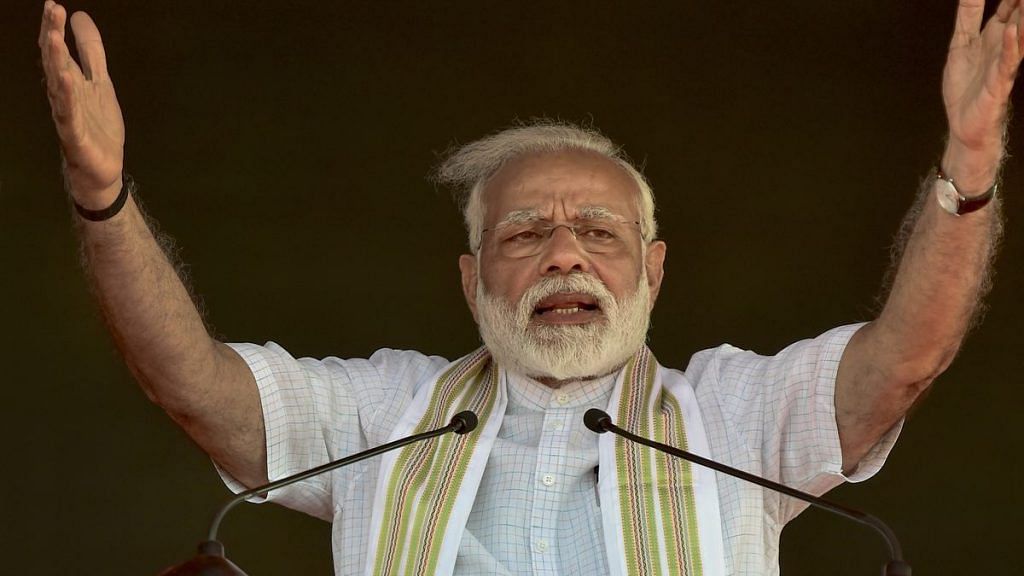Polling in two-thirds of all parliamentary constituencies in the Lok Sabha 2019 elections is over, and voting in the fifth phase has begun today. Poll experts appear befuddled over which direction the election is trending. Television anchors with cameras accost voters with questions on voting intent, analysts wrap their heads over inane voter turnout data in the hope of spotting a trend, foreign journalists and social media warriors spout opinions collected from anecdotes in their election tourism expeditions.
Yet, all this has only generated more noise rather than any real signals. The larger trend of the 2019 elections is the phenomenon of the silent voter and the extreme localisation of national elections.
Also read: With 5 clean chits to Modi, EC made it clear: BJP Varanasi nominee is free to say anything
There are some very clear takeaways thus far in the 2019 elections. One, there is no ‘wave’ for the ruling party, as in 2014, as even the most ardent supporters of the BJP will admit. Two, there is a silent clamour for change. Three, for the first time in recent memory, a ruling party is seeking re-election not on its performance in the last five years, but on some intangible idea of nationalism. Four, this is not a national election, at best it is an election of 29 different states, but it is more like a ‘543 constituencies’ election. Five, traditional methods of election forecasting by using vote share from a survey of voters across the country to predict seats is defunct.
There is no clearer evidence of a lack of a 2014-type wave than the campaign rhetoric of Prime Minister Narendra Modi that plumbs to deeper lows with every phase of the election. From threatening to use the nuclear button to claiming that the opposition parties dream of his death to mocking the death of former Prime Minister Rajiv Gandhi who was assassinated brutally, Modi has made it abundantly clear that he is in a state of absolute panic and despair over how the current election is trending for his party.
The elevated hopes of hundreds of millions of voters in 2014 and the subsequent dashing of them have led voters to become more sceptical and transactional about the 2019 elections. Voters are increasingly more concerned about the tangible impact on their daily lives such as jobs, incomes, prices etc., rather than some vague national or ideological pursuits. Such tangible needs also vary widely across constituencies and states.
Also read: Here’s how many seats Congress can win in 2019 Lok Sabha elections
For eg., the Sterlite issue is the defining electoral issue in Tuticorin, Tamil Nadu while stray cattle is the defining issue in Maharajganj in Uttar Pradesh. Thus, the 2019 election has got very localised and feels like 543 different elections. This means that the voter’s behaviour in this election is not being shaped by some national narrative, but by local factors such as the menu of choices on their ballot, substantial ideas that impact their livelihoods immediately and their trust in candidates.
With elections becoming localised, there is an accompanying desire for change at the constituency level. But this desire is silent and cautiously expressed. We have run multiple experiments across various states to survey the same set of voters with the same set of questions on the same day but in different contexts, only to find that the responses vary dramatically depending on the interviewer and the circumstances. We find that a supporter of the ruling NDA is much more vociferous and expressive than the one desirous of a change. In other words, a non-BJP supporter seems far likelier to abstain from responding to questions or falsifying their preferences, if forced. This is referred to as the ‘silent voter’ phenomenon in political science. The most famous observation of the ‘silent voter’ phenomenon in the Indian context was in the 2004 Lok Sabha elections.
This silent voter phenomenon could also explain why 85 per cent of exit polls since 2014 across all state elections have been wrong. Our analysis of 110 exit poll seat predictions of 15 state elections since 2014 by the most frequent four polling agencies – Cvoter, Axis, CSDS and Chanakya, show that they were wrong 85 per cent of the time.
Also read: Why voters don’t turn up in larger numbers in Lok Sabha elections – all politics is local
Localised elections combined with a severe ‘silent voter’ problem have rendered most predictions by pollsters erroneous. In order to be able to accurately survey and predict, one must survey every constituency with a well-stratified sample that does not induce a ruling party bias. This is an expensive proposition. Most pollsters in the country lack the resources and the know-how to do this.
Where does all this leave us with the current Lok Sabha election? In states such as Tamil Nadu, the desire for change is loud but in states like Maharashtra, there is a strong but subdued vote for change. At this point, I can venture to say that it is sufficiently clear from our extensive surveys of every assembly constituency with a large sample size that at the end of the first four phases of polling, the Congress party with its pre-poll alliances is ahead of the BJP and its pre-poll alliance parties.
Now, you are entitled to dismiss this as the opinion of a biased sample of one person! I can only submit that there is strong empirical evidence to back this claim.
The author is the Chairman of the Data Analytics department of the Congress party. Views are personal.
